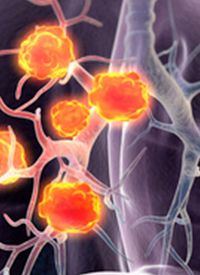Article
Sintilimab Combo Extends PFS in Previously Treated EGFR-Mutated NSCLC
Author(s):
Sintilimab in combination with a bevacizumab biosimilar plus pemetrexed and cisplatin induced a progression-free survival benefit of 2.6 months compared with chemotherapy alone for patients with EGFR-mutated, locally advanced or metastatic non–small cell lung cancer, according to interim findings from the ongoing phase 3 ORIENT-31 trial.

Sintilimab (Tyvyt) in combination with a bevacizumab (Avastin) biosimilar (Byvasda) plus pemetrexed (Alimta) and cisplatin induced a progression-free survival (PFS) benefit of 2.6 months compared with chemotherapy alone for patients with EGFR-mutated, locally advanced or metastatic non–small cell lung cancer (NSCLC), according to interim findings from the ongoing phase 3 ORIENT-31 trial (NCT03802240).1
The median PFS was 6.9 months (95% CI, 6.0-9.3) for patients assigned to sintilimab plus Byvasda and chemotherapy compared with 4.3 months (95% CI, 4.1-5.4) for those assigned to pemetrexed and cisplatin alone (HR, 0.46; 95% CI, 0.34-0.64; P <.0001). The estimated PFS rate was 59% (95% CI, 49%-68%) in the sintilimab/Byvasda arm vs 30% (95% CI, 22%-39%) in the chemotherapy alone group at 6 months and 28% (95% CI, 18%-39%) vs 12% (95% CI, 7%-20%), respectively, at 12 months.
These findings included data collected on 293 patients as of the July 31, 2021, data cutoff. The median follow-up was 9.8 months.
“The prespecified subgroup analysis showed that the HR for progression-free survival favored patients receiving sintilimab plus [Byvasda] plus chemotherapy over those receiving chemotherapy alone across most subgroups, including patients with brain metastases,” investigators wrote.
The double-blind, multicenter trial examined the use sintilimab, with or without a bevacizumab biosimilar injection, combined with chemotherapy in patients with EGFR-mutant disease that had progressed following treatment with an EGFR TKI. Investigators enrolled 600 Chinese patients who received 1 of 3 regimens.
The first arm received 200 mg of intravenous sintilimab plus 15 mg/kg of the biosimilar, 75 mg/m2 of cisplatin, and 500 mg/m2 of pemetrexed every 3 weeks. The second arm combined the sintilimab backbone with pemetrexed, cisplatin, and placebo every 3 weeks. In the active comparator arm, patients were administered pemetrexed and cisplatin plus 2 placebos every 3 weeks.
PFS was the primary end point. Secondary end points included overall survival and overall response rate.
Eligible adults were aged 18 to 75 years and had been diagnosed with histologically or cytologically confirmed stage IIIB or IIIC disease that is not eligible for resection or radical concurrent chemoradiotherapy. Patients also needed to have an EGFR-mutated tumor confirmed via tumor histology or cytology, resistance to an EGFR TKI, and an ECOG performance status of 0 or 1.
Investigators randomly assigned 148 patients to the sintilimab/Byvasda arm and 151 to chemotherapy alone. Another 145 were assigned to sintilimab plus chemotherapy, but the futility analysis for PFS between sintilimab plus Byvasda and chemotherapy and sintilimab plus chemotherapy arms did not cross the futility boundary (HR, 0.73; 95% CI, 0.53-1.0).
As assessed by an independent radiographic review committee, the objective response rate was 44% (95% CI, 36%-52%) in the sintilimab/Byvasda arm compared with 25% (95% CI, 19%-33%) in the chemotherapy alone arm. Median time to response was 1.4 months (interquartile range [IQR], 1.3-2.7) with a median duration of response of 8.3 months (95% CI, 5.4-12.1) in the combination arm vs 1.5 months (IQR, 1.4-2.8) and 7.0 months (95% CI, 4.1-8.3), respectively, in the chemotherapy alone arm.
Twenty-five (17%) patients in the sintilimab/Byvasda/chemotherapy arm, 12 (8%) in the sintilimab/chemotherapy arm, and 10 (7%) in the chemotherapy alone arm experienced treatment-emergent adverse effects (TEAEs) leading to treatment discontinuation. Forty-one (28%) patients in the sintilimab/Byvasda/chemotherapy arm, 23 (16%) in the sintilimab/chemotherapy arm, and 37 (25%) in the chemotherapy alone group experienced serious treatment-related AEs.
Eight (5%) patients in the sintilimab/Byvasda/chemotherapy arm experienced grade 5 TEAEs, including 6 incidents deemed possibly treatment related. There were 4 (3%) TEAEs leading to death in the chemotherapy alone arm, 1 of which was possibly related to treatment. There were no TEAEs leading to death in the sintilimab/chemotherapy arm.
In February 2022, the FDA’s Oncologic Drugs Advisory Committee (ODAC) voted against using single-country foreign data to support a biologics license application (BLA) for sintilimab injection plus pemetrexed and platinum-based chemotherapy for the frontline treatment of patients with NSCLC. ODAC concluded that supporting data from the phase 3 ORIENT-11 trial (NCT03607539), conducted entirely in China, could not be applied to the US population and ordered drug maker Innovent Biologics (Suzhou) to conduct a new trial in the United States.2
Innovent filed the BLA in 2021 based on findings from ORIENT-11 demonstrating that the regimen significantly improved PFS compared with chemotherapy alone in the frontline treatment of patients with locally advanced or metastatic nonsquamous NSCLC.3 However, ODAC committee members noted that the study population was younger, predominantly male, and included lower rates of smokers than are generally found in the United States.
References
- Lu S, Wu L, Jian H, et al. Sintilimab plus bevacizumab biosimilar IBI305 and chemotherapy for patients with EGFR-mutated non-squamous non-small-cell lung cancer who progressed on EGFR tyrosine-kinase inhibitor therapy (ORIENT-31): first interim results from a randomised, double-blind, multicentre, phase 3 trial. Lancet Oncol. Published online July 28, 2022. doi:10.1016/S1470-2045(22)00382-5
- FDA Briefing Information for the February 10, 2022, Meeting of the Oncologic Drugs Advisory Committee. Accessed August 2, 2022. bit.ly/3rHByaX
- US FDA accepts regulatory submission for sintilimab in combination with pemetrexed and platinum chemotherapy for the first-line treatment of people with nonsquamous non-small cell lung cancer. News release. Innovent Biologics, Inc; May 18, 2021. Accessed August 2, 2022. https://prn.to/2RsrJOD








